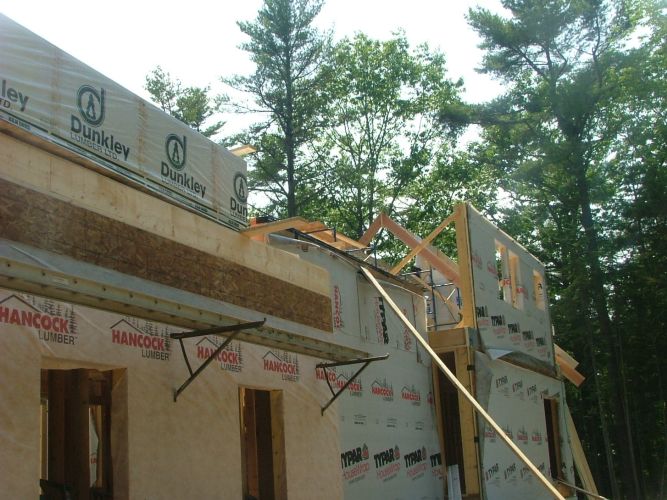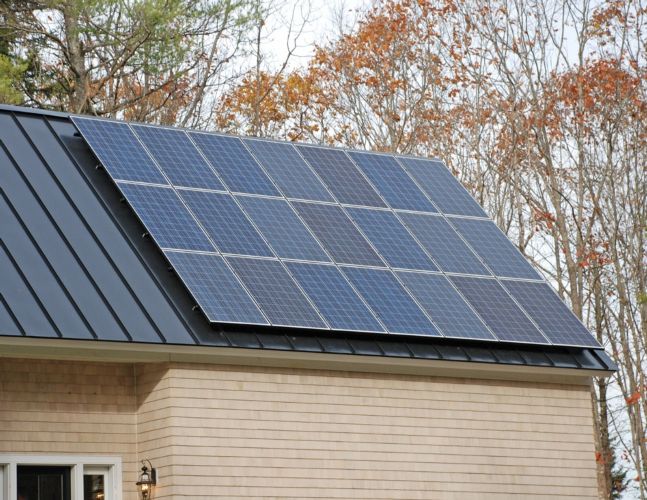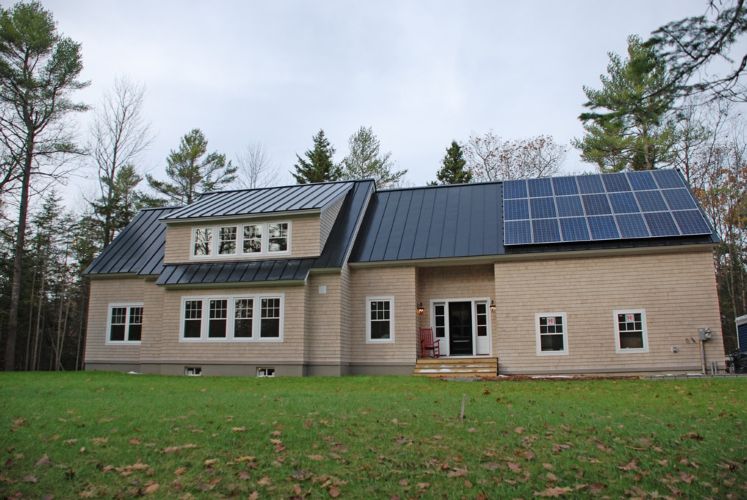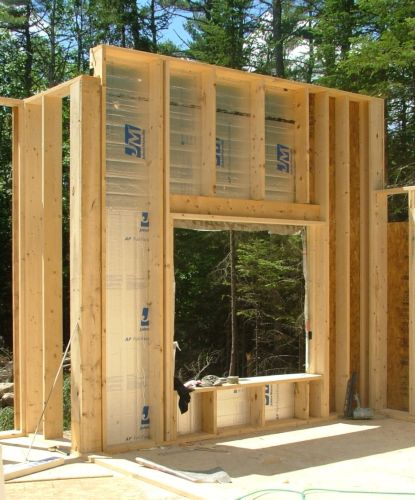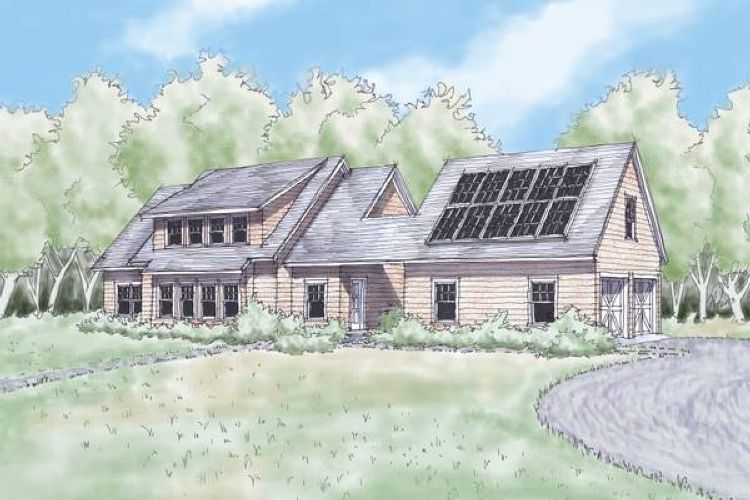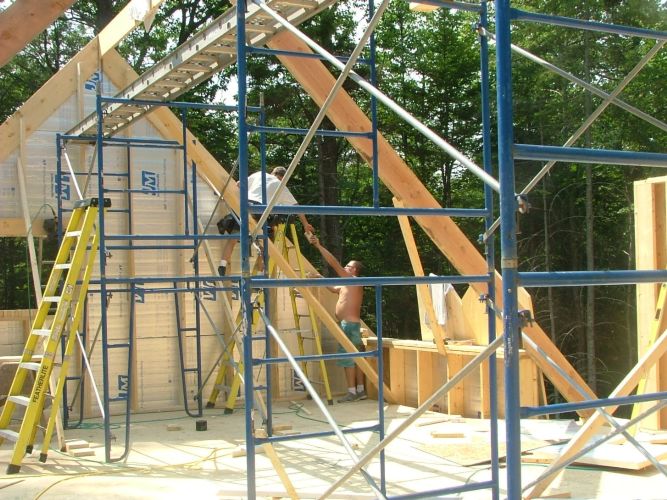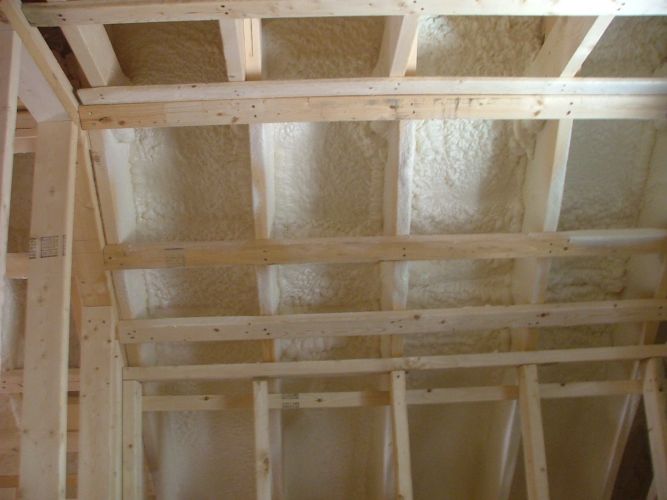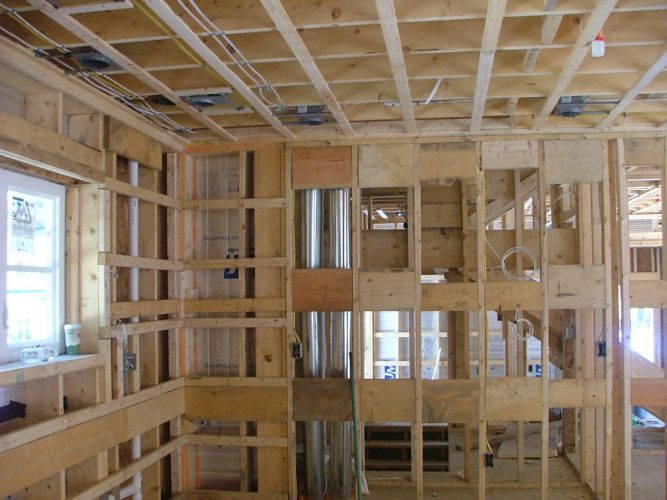Featured Project Return to Projects List
Net Zero Energy Homes
Project Information
- Project Location:
- Freeport, ME
- Status:
- Completed
- Structure Type:
- Residential Building
Scope Of Work
This exterior wall reveals our framing system
We designed the framing system you can see revealed in this first floor bedroom wall.Our goal is to maximize the R-factor, a measure of a building’s resistance to heat loss. The higher the R-factor,the more efficient the home will be to heat and cool. With this in mind, we frame walls with 2 x 8 studs, as opposed to traditional 2 x 6 construction.
Next we sheath the exterior with 2″ foam board attached to plywood. Finally, we apply 2″ x 3″ horizontal strapping to the inside of this wall. When the wall cavity is filled with dense packedcellulose insulation, our walls achieve an R-factor of 45. Compare this with the R-22 of a traditional 2 x 6 frame with fiberglass insulation. At this stage of construction, this new home is well on its way to becoming energy independent.
SUPER INSULATED ROOF FRAMING SYSTEM
Once the second floor deck is built, and the walls are framed we are ready to start framing the roof. We use 2 x 12 rafters which, along with 2 x 3 strapping on the slopes, provide the depth needed to insulate the exposed roof ceiling to R-58. The strapping acts as a thermal break. It prevents the framing timbers from being in contact with outside cold and inside warmth.
The R-58 in the sloped ceiling is achieved by using 3″ of spray foam along with 10″ of densely packed cellulose. Spray foam has the highest insulating value of any insulation. It is also the most expensive, yet is necessary to achieve near R-60
After 3″ of spray foam is sprayed between the rafters, 9″ of cellulose is blown into these cavities. The cellulose is held in place by Insulweb, a permeable fabric that allows moisture from condensation off the roof frame to dry toward the inside of the house.
BEHIND THE WALLS
The framed interior is the skeleton of the house. Studs outline rooms ready for the vital elements that, though hidden, will integrate to make this a comfortable home. At this stage of construction, the electrician and plumber work side by side. Wires thread through walls to outlets. Water lines position for sinks, toilets and showers. At the same time, a sprinkler system is installed, as required by Freeport building code.
FRESH AIR
The Heat Recovery Ventilation System (HRV), essential to a super-insulated air sealed house, now appears. Ducts remove stale air from the kitchen and bathroom areas, and provide fresh air to the bedrooms and common areas. The HRV is a critical element in building this zero energy home, providing a safe, healthy living environment.
PULLING HEAT OUT OF THIN AIR
This house will be heated by ductless mini-split heat pumps. Unlike traditional combustion heating systems, the heat pump does not burn fuel. Rather, it moves heat from one place to another. The system consists of one to one indoor and outdoor units. The indoor unit acts as the condenser in the refrigeration cycle where heat extracted from the outdoors is brought inside the house through an ultra efficient and nearly silent fan which circulates air through the unit. The outdoor unit acts as the evaporator and gathers heat from the surrounding environment to vaporize the refrigerant. In summer, the heat pump can reverse the process by circulating cool air extracted from the sweltering outdoors. Quieter than a refrigerator and economical to operate, the heat pump can cut the home owner’s heat bill in half. On average, for every unit of electricity used to operate, 3 units of heat are moved. This translates to a comparable $1.50/gallon for oil. The heat pump will pay for itself in 5 years with an expected life of 15-20 years. For information on Rebates and Tax Credits, see Efficiency Maine.
Net Zero Energy Homes SOLAR POWER
Our solar electric system harvests free clean renewable energy from the sun. The system is ‘grid tied’, meaning that it works without the use of batteries. Rather, it interacts directly with the electric grid, allowing one to either use solar power in real time or bank electricity as credits for use at night or during rainy days.
Anticipation of Solar dictated the siting of the house: First, the roof must face south, and second, the south facing roof space should be located in a shade free area. Ideally, there will be a clear solar window from 9a.m. to 3p.m.
This house features a 5.355 kw array of Canadian solar modules installed on the south facing garage roof. The panels attach easily to standing seams of the metal roof. This system will produce roughly 7.138kWhrs of clean electricity annually, more than enough to satisfy the energy needs of this household. In addition, this system will offset roughly 8500 lbs of CO2 emissions annually. Tapping solar power saves money while protecting the environment.
A CLEAR VIEW
Triple glazed windows provide an essential component of the zero energy home. They successfully juggle the factors of heat loss and solar gain, while maintaining visual clarity. A good triple glazed casement window provides high levels of insulation and air tightness.
